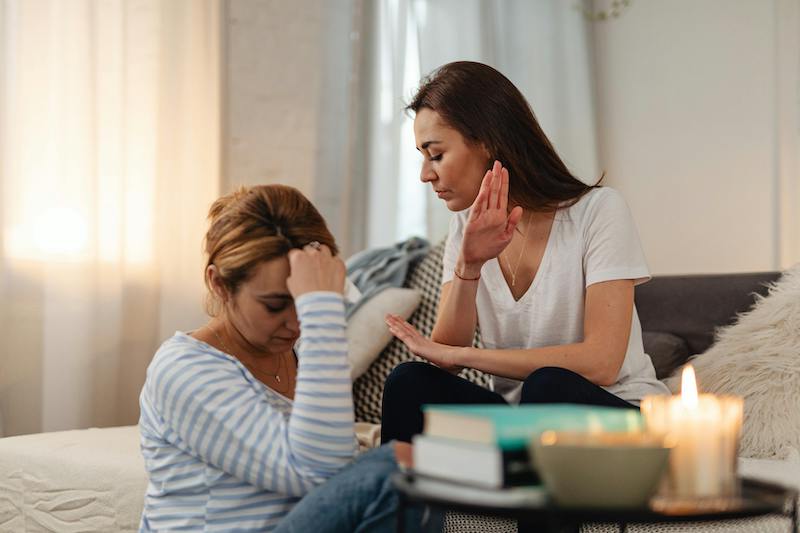Most people can’t tell the difference between codependency vs love until years into a relationship. By then, they’ve overridden so many internal signals that they’ve lost track of what safety actually feels like.
But here’s what I’ve learned working with people navigating betrayal and relationship trauma: your body knows the distinction between codependency vs love long before your mind does. The challenge is that we’re not taught to pay attention to what our bodies are telling us about our relationships.
What Is Codependency?
Codependency isn’t about caring too much or being too giving. It’s a survival pattern where you override your body’s signals in order to maintain connection.
It’s the instinct to stay attached even when your nervous system is telling you something is wrong. It’s choosing the relationship over your own internal truth because the fear of being alone feels more threatening than the cost of staying.
In codependency, you dismiss what you feel to keep the peace. You make yourself smaller to avoid conflict. You lose track of your own needs and boundaries. Your sense of safety depends entirely on the other person’s mood and availability, and you find yourself constantly monitoring and managing their emotions.
Codependency is driven by attachment—the deep, primal need to not be alone. That drive is so powerful it can hijack your ability to detect danger, discomfort, or misalignment.
What Is Healthy Love?
Love doesn’t require you to abandon yourself.
In a healthy, loving relationship, you can be yourself without performing or managing. Your needs matter as much as theirs. Conflict doesn’t threaten the entire relationship. You can say no without fear of rejection or retaliation. Your body relaxes in their presence over time.
Love creates space for both people to exist fully. It doesn’t demand that you override your instincts, ignore your boundaries, or betray what you know to be true about yourself.
Codependency vs Love: The Key Difference
Here’s the distinction that matters most when examining codependency vs love: love lets your nervous system settle. Codependency keeps it activated.
How Codependency Feels in Your Body
In codependency, your body stays in a state of activation. Your shoulders brace, your chest tightens, your jaw clenches. You develop a hypervigilance, constantly scanning for signs of displeasure or withdrawal. There’s a flutter of anxiety in your chest when you think about bringing up a concern. When conflict arises, you freeze—going silent and compliant when you meant to speak up. You collapse your own needs to accommodate theirs. There’s a persistent feeling that there’s more to the story, that something’s not quite right.
How Love Feels in Your Body
In love, your body can relax. Your shoulders drop, your breath deepens. You can be still without anxiety. Your chest opens rather than contracts. You feel grounded in your own presence. Conflict feels manageable, not catastrophic. You can advocate for yourself without your nervous system flooding.
Your body knows whether it’s safe with this person. It knows whether you can trust them with your anger, your needs, your boundaries. It knows whether you have to perform to keep them close or whether you can simply be.
Signs You’re in Codependency vs Love
Understanding the difference between codependency vs love requires paying attention to what happens in your body.
Signs of Codependency
If you feel disgust or revulsion toward your partner but dismiss it as “your issue,” that’s information. If your body braces or tightens during certain conversations, that matters. Notice when you find yourself shrinking, going quiet, becoming compliant. Notice if there’s a sense of dread or heaviness about bringing up your needs.
In codependency, you’re constantly trying to read their mood to know how to be. After interactions, you feel depleted rather than nourished. You override discomfort because the fantasy of what the relationship could be feels more real than what it actually is.
Signs of Healthy Love
In love, your body softens and opens in their presence. You can bring up concerns without your system flooding. Conflict feels hard but not dangerous. You maintain a sense of yourself even when attached to them. You can tolerate their displeasure without collapsing. After time together, you feel more like yourself, not less.
The Anger Test
One of the most important signals to track when distinguishing codependency vs love is how their anger feels in your body. Not whether they get angry—everyone does—but the quality of it. Does their anger make you freeze, brace, or shrink? Do you find yourself managing it, walking on eggshells around it, or absorbing it into your own system? Your body registers whether someone’s anger is safe before your mind has words for it.
Why Codependency Feels Like Love
Codependency can feel intensely like love because attachment is a powerful physiological force. The bond itself creates chemistry, familiarity, a sense of coming home.
When you come from early trauma or unstable attachment, codependent dynamics can feel more familiar than healthy love. The hypervigilance, the need to manage and monitor, the intensity of the connection—these feel like passion, like depth, like “this person really matters.”
We override what our bodies tell us because we desperately want connection and fear being alone. We’re chasing a fantasy of who this person could be or what the relationship could become. Early relational patterns taught us that staying connected mattered more than staying safe. We learned to dismiss our own signals as “too sensitive” or “making problems.”
The attachment system is designed to keep us bonded even when it’s not in our best interest. That’s why your mind can rationalize, explain away, or justify what your body is clearly communicating.
Moving From Codependency to Love
The first step in shifting from codependency toward love is simply noticing. Not fixing, not leaving, not changing anything yet—just noticing what your body is actually telling you.
Start paying attention to when your body braces or contracts around this person. Notice when you override a clear signal to keep the peace. Track what happens in your system when you think about asserting a boundary. Pay attention to how you feel after spending time with them—more yourself or less?
Healing codependency isn’t about finding the right person or fixing your attachment patterns overnight. It’s about learning to stay with your body’s truth, even when attachment is screaming for you to reach outward instead.
It’s about sourcing safety from within first—feeling your feet on the ground, your breath steady, your own presence—before looking to someone else to provide it.
This is slow work. It means learning to tolerate fear, discomfort, and possibly aloneness. It means holding your needs as valid and your boundaries as non-negotiable. It means trusting that the information in your body is real, even when your mind wants to dismiss it.
Learning to Trust Your Body’s Wisdom
Your body will keep telling you the truth about your relationships until you’re finally ready to listen.
When you’re trying to understand codependency vs love in your own relationship, the most reliable guide is your nervous system. Codependency feels like love because the bond is real. But love doesn’t require you to abandon yourself to maintain it.
The difference is in what your nervous system does. Love lets you settle. Codependency keeps you activated.
Learning to tell the difference—learning to trust what your body is communicating—is the work that brings you back to yourself.
Ready to Heal Codependency Patterns?
If you’re recognizing codependency patterns in your relationships and want support learning to trust your body’s signals, I work with individuals navigating betrayal, attachment trauma, and relationship recovery. Schedule a complimentary consultation here.


